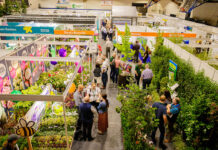In The Botany of Desire: A Plant’s-Eye View of the World (© 2001 ISBN 0-375-76039-3), Michael Pollan explores the concept of civilization’s co-evolution with four important horticultural crops: apples, tulips, marijuana, and potatoes. Each of these species have been selectively grown, bred, and engineered to satisfy four fundamental human desires: sweetness, beauty, intoxication–pain relief, and control.
The apple helped satisfy our desire for sweetness long before the introduction of processed sugars and high-fructose corn syrup. The quest for the most beautiful tulip caused a speculation frenzy in Holland some three and a half centuries ago, where a single bulb would sell for the equivalent price of a townhouse. Marijuana was domesticated for fiber, intoxication, and the alleviation of pain, while the development of genetically modified potatoes exemplifies humankind’s desire for control of nature and commercial dominance of the marketplace.
Agriculture & Bumblebees
The book is an interesting read. Mary Ruth McDonald, a plant pathologist and horticulturist at the University of Guelph, makes it required reading for her graduate students. It is an excellent critique of the domestication of some important horticultural crops and their role in civilization. There is the unique element of human intervention, or what Pollan refers to as the “human bumblebee”. Like the bumblebee, we spread the genes of selected species and increase their habitat. The bumblebee is initially attracted to the flower color and satisfies its sweet tooth by sipping nectar. However it is the unique angiosperms with their large, showy flowers that have co-evolved to entice the insect into carrying pollen from one flower to the next. (Pollan does not suggest that a flower “tricks” an insect or animal into paying a visit, but rather it is an adaptive trait that occurs through evolution.) “Design in nature is but a concatenation of accidents, culled by natural selection until the result is so beautiful or effective as to seem a miracle of purpose”. However, Pollan contends that humankind is more like the bumblebee than “master of nature”.
The development of Agriculture some 10,000 years ago caused a paradigm shift in plant diversity—humans got into the mix of increasing plant habitat (cutting down forests to plant food crops) and spreading their genes around the planet; i.e. prior to Christopher Columbus you could not eat a decent pizza in Rome, Italy; it was in the late 1500s that the Solanaceae (tomatoes, peppers, chilies, potatoes) would be introduced to Europe—but that is another horticulture story! Charles Darwin wrote of human intervention into plant dissemination and domesticated species as “artificial selection”. Pollan notes this human–plant arrangement has been “a peril for some species, an opportunity for others.” But with the invention of agriculture, plants also enabled us to settle down and start farming—they allowed us to evolve from hunter–gathers and establish more “civilized roots.”
The Apple
As horticulturists, we know that the apple originated from the former Soviet Republic of Kazakhstan, was dispersed through Europe, and made its way to North America. There really was a Johnny Appleseed (John Chapman). In the early 1800s, Chapman was populating the Northwest Territory (western Pennsylvania, Ohio, and Indiana) with seedling apples. While apples were clonally grafted in England, Chapman considered it “unnatural” and used seed propagation. At the time only crabapples were native to the United States, not Malus domestica, the common apple. Through Chapman, sexual propagation led to adaption of new habitats for apples in the Americas and countless new varieties.
In practice, Chapman was a shrewd landsman, operating a chain of nurseries that would extend from the Ohio River Valley in western Pennsylvania to Ohio and Indiana. A condition of the deed for land grants in the Northwest Territory required a settler to “set out fifty apple or pear trees.” Maybe we need some similar requirements to counteract some of the urban sprawl plundering prime U.S. farmland! Chapman sold trees to the settlers and established fruit trees on his land holdings.
But we know that seed-produced apples are highly variable and can be bitter. Chapman was bringing something else to the developing West—applejack, made by concentrating hard cider. Turns out that hard booze and sugar (sweetness) were both in short supply for the pioneers settling and pushing west. Prior to the late 1800s when sugar became more available, sweetness for most Americans was supplied by fruits.
The Tulip
Flowers and beauty have been closely linked in all of the great civilizations. Since it was first introduced from the Ottoman Empire (Turkey) into Europe, the tulip has been continually modified to reflect our changing tastes of beauty. However it was “Tulipomania” which hit conservative, wealthy, Calvinist Holland between 1634 to 1637. The “irrational exuberance” of tulipomania was all about financial speculation—not of pleasure or consumption. The quest for owning the perfect tulip flower was akin to acquiring the “hottest stocks” in the economically damaging bubbles and bursts of the more recent dot-com/internet and housing booms. The voracious passion for the tulip had much to do with the plants recent appearance in Europe—it was new, exciting, and beautiful. The Dutch started breeding and selecting for the most exotic mix of flower colors: “color breaks,” which were inadvertently caused by a virus spread from tulip to tulip. This weakened the production of offsets (smaller and fewer bulblets were produced), and ultimately led to higher speculative prices for these exotic tulips. The viral infection unwittingly selected for was decreasing the fitness of the tulip. Interestingly, by the 1920s, the Dutch regarded tulips as a commodity and screened against color breaks caused by virus transmission. How our civilized perception of beauty changes over time!
Marijuana
For Pollan, “plants are nature’s ultimate organic chemists—manufacturing chemicals that ‘… nourish, heal, poison, delight the senses, rouse us, put us to sleep, intoxicate, and even alter consciousness . . .’.” Why do plants go to all the trouble to make so many complex molecules and expend the energy needed to manufacture them? Since plants cannot move (locomote) out of harm’s way, some of these chemicals (poisons, toxins, hallucinogens) are used to repel herbivores. This brings us to marijuana: domesticated by the Chinese some 15,000 years ago and initially used for hemp fiber, which was the most important fiber for paper, cloth, and rope until the invention of the cotton gin.
All human cultures have had a psychoactive plant [coffee, tea, coca, alcohol (grapes/grains), cannabis, tobacco, opium] except the Eskimo. Marijuana is a crop used for intoxication, but also for pain relief, childbirth, anti-inflammatory, and anti-insomnia. Interestingly, there are some 16 U.S. states that have legalized the use of medical marijuana. Gary Stutte and Kerrie Badertscher are organizing a workshop on Medicinal Marijuana at the September 2011 ASHS Annual Conference in Hawaii. It is important that ASHS take part in the “conversation” of medical marijuana usage. The workshop will cover legal ramifications, and medical–pharmacological issues to production systems. Since legalized medicinal marijuana is prescribed as a drug, dosage, THC, and other quality control issues need to be addressed. In the March 6, 2011, Sunday New York Times, there was a piece on the medical marijuana industry in Montana, which by law must be grown indoors under controlled environment agricultural (CEA) systems. It has been a boon to the economy and even employs some Environmental Horticulture majors from Montana State University.
Despite our failed drug policies, Pollan does not endorse outright legalization of drugs. While it is human nature to change consciousness (i.e., altering our brain chemistry through meditation, exercise—turning on endorphins, caffeine, alcohol) we should not be doing it all the time. Pollan alludes to the ancient Greeks, who used wine but created controls and rituals for its consumption. They understood that plant drugs were both good and evil. Hence, the Greek word “pharmacon,” which means a medicine/drug, but also a poison.
The Potato
Pollan delves into our desire to control nature by producing the perfect genetically modified potato. This is a quantum leap in our relationship to the plant world with genetic modification. He centers on Monsanto’s ‘New Leaf’ Bt potato. “They have pesticide in every cell, bacterial toxin . . . so they kill their own bugs. One of the premises of the biotech industry is what they are doing is really no different than selective breeding and they compare it to fermentation and cheese making; they call all these things biotechnology. But in fact what they’re doing is incredibly novel. We never before have been able to take genes from a flounder and put them in a tomato or firefly and put them in tobacco. This is something extraordinarily new. And I think whenever we do something radically new in nature, we have to proceed with great caution”.
The human quest to control nature through domestication can be overdone. Pollan points out that when we rely on too few genes for too long, a species loses its ability to survive on its own. This happened to the “Irish” potato in the 1840s and may be happening with today’s domesticated apple and other crops.
Many horticulturists, agronomists, and citizens are concerned about the privatization of genes, genetically modified organisms (GMOs), and the concentration of germplasm among fewer and fewer companies. To Pollan, the real issue is not GMOs increasing yield. He writes that GMOs have not increased productivity, except for Bt corn in years of high infestation of European corn borers. The real issue of GMOs is the control of intellectual property of the food crops. Pollan endorses open-source genetic engineering for intellectual property, needed to “make the system more sustainable and less brittle.” He argues that increases in yield during the past 20 years are due to conventional breeding, which is “withering on the vine.” GMOs allow farmers to expand their monoculture systems because it takes less management. The jury is still out, and the debate goes on!
It’s all about Horticulture: essential for our daily sustenance, interwoven with the tapestry of civilization, and sometimes quite controversial!
Source: American Socity for Horticultural Science – The Botany of Desire: It’s All About Horticulture!







